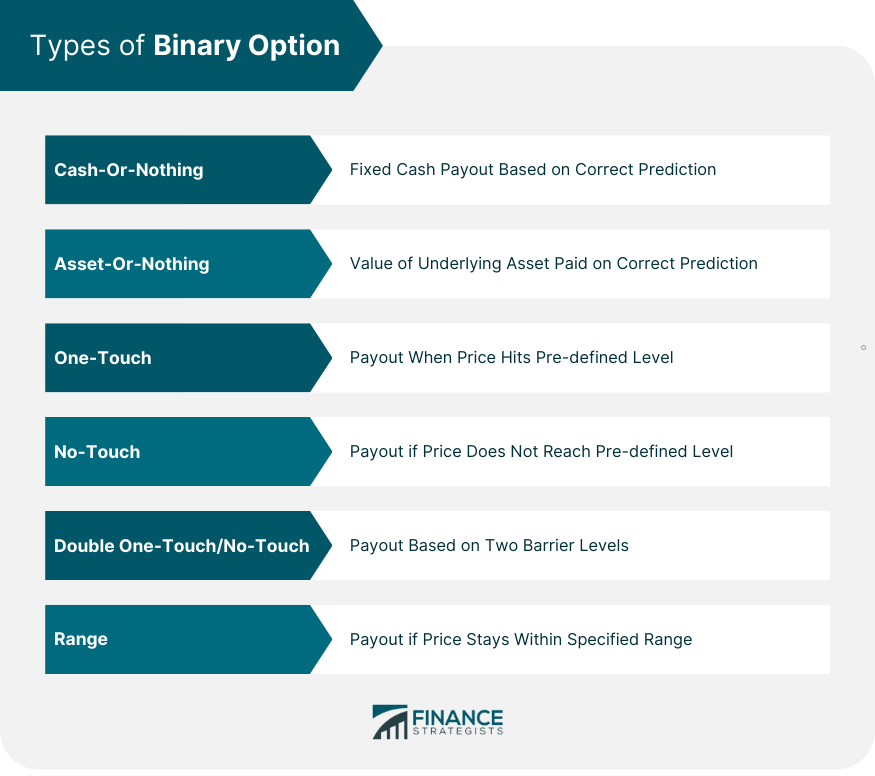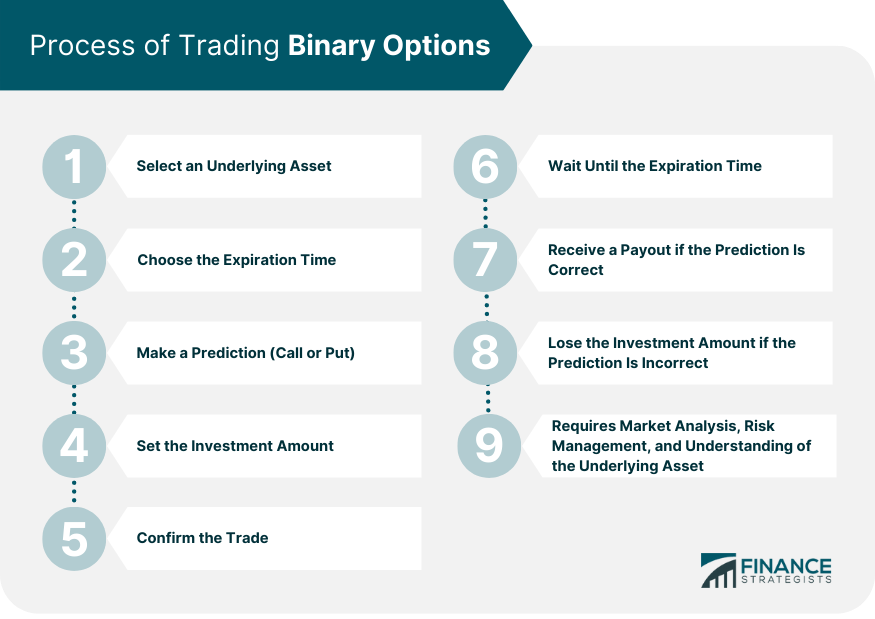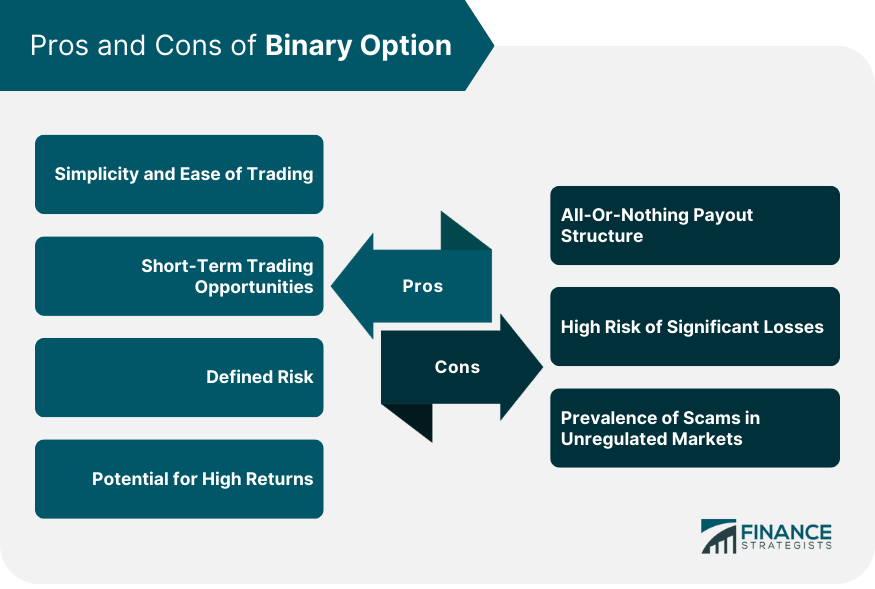A binary option is a financial instrument known as a derivative. They allow an investor to make a bet on the price movement of an underlying asset, such as a stock, commodity, currency, or index. The term 'binary' is used because there are only two possible outcomes in a binary option trade: a fixed profit or a fixed loss. The outcome depends on whether the price of the underlying asset is above or below a specified level at a predetermined time, often referred to as the 'expiry time.' If the investor's prediction is correct, they receive a fixed payout, usually a percentage of the investment amount. If the prediction is incorrect, they lose the entire amount invested. A binary option is known for its simplicity, but they also carry significant risks, as the potential for loss is high. Cash-or-nothing binary option is the most common type. Here, an investor receives a fixed cash payout if their prediction is correct and nothing if it's not. In the asset-or-nothing binary option, the trader receives the value of the underlying asset if their prediction is correct. If not, they receive nothing. One-touch binary option payout once the price of the underlying asset hits a predetermined level at any point before the expiry time. The no-touch binary option payout if the price of the underlying asset doesn't reach a predetermined level before the expiry time. Double-one-touch or double-no-touch binary option have two barrier levels. If the asset's price touches either of the levels in a double-one-touch option or doesn't touch either level in a double-no-touch option, the trader receives a payout. Range binary option, also known as boundary option, involves predicting whether the asset's price will stay within a specified range until expiry. The process of trading binary options involves several steps. Firstly, you need to select an underlying asset that you want to trade. This can include currencies, stocks, commodities, or indices. Next, choose the expiration time for the option, which determines how long the trade will remain active. Then, make a prediction on whether the price of the underlying asset will rise or fall within the chosen expiration time. Based on your prediction, select the appropriate type of binary option, either a "call" option if you expect the price to rise or a "put" option if you expect the price to fall. Set the investment amount or stake for the trade. Once you have confirmed the trade, you will need to wait until the expiration time. If your prediction is correct, you will receive a predetermined payout. However, if your prediction is incorrect, you will lose the investment amount. It is important to consider the market analysis and risk management and have knowledge of the underlying asset before engaging in binary options trading. Choosing a binary option broker is crucial. Consider factors like regulatory status, payout rates, customer support, and the range of assets offered. Different brokers offer different trading platforms. It's important to understand how to navigate these platforms, including reading price charts, understanding payout ratios, and placing trades. Placing a binary option trade involves choosing an asset, selecting 'call' or 'put' (predicting the price will rise or fall, respectively), deciding the investment amount, and confirming the trade. Successful binary option trading requires effective risk management strategies. These may include setting limits on trades, diversifying your portfolio, and using strategies like hedging or straddling. Intrinsic value in binary option is the amount an option would payout if it expired immediately. Time value, on the other hand, represents the possibility of the option increasing in value before expiry. Several factors influence binary option prices, including the underlying asset's price, the option's expiry time, and the market's volatility. The Black-Scholes model is commonly used to price binary option. This mathematical model calculates the theoretical price of an option based on various factors, including risk-free interest rate, time until expiration, volatility, and strike price. The benefits of trading binary option include their simplicity, defined risk, short-term trading opportunities, and potential for high returns. The risks and downsides include the all-or-nothing nature of the trade, the potential for significant losses, and the prevalence of scams in unregulated markets. Regulatory authorities, like the SEC and CFTC in the US, play a crucial role in safeguarding traders, preventing fraud, and ensuring fair and transparent trading. The regulatory framework for binary option varies across countries. Some, like the US, have strict regulations, while others, like the EU, have banned binary option altogether. Unfortunately, scams are prevalent in binary option trading. Traders can avoid them by trading with regulated brokers, researching before investing, and being cautious of promises of high returns with low risk. Fundamental analysis involves evaluating an asset's value by examining related economic and financial factors, such as company earnings, economic indicators, and market conditions. Technical analysis uses statistical trends gathered from trading activity, like price movement and volume, to predict future price trends. Popular binary option trading strategies include trend strategy, straddle strategy, risk reversal strategy, and hedging strategy. Binary options are a popular financial instrument used in various markets for speculative trading and risk management. Binary Option in Forex Market: Allows traders to bet on the relative price movements of different currency pairs. Binary Option in Stock Market: Enable traders to speculate on whether a specific stock's price will rise or fall. Binary Option in Commodities Market: Allows traders to bet on the price of commodities like gold, oil, or agricultural products. Binary Option in Cryptocurrencies: Extend to the volatile cryptocurrency market, where traders can bet on the price movements of popular cryptocurrencies like Bitcoin and Ethereum. Binary option, as financial derivatives, offer a straightforward way to speculate on the price movement of various assets. They provide only two potential outcomes - a fixed profit or a fixed loss - contingent on the correct prediction of an asset's price at a given expiry time. Diverse types of binary option, including cash-or-nothing, asset-or-nothing, one-touch, no-touch, double one-touch/double no-touch, and range option, provide traders with a myriad of trading opportunities. However, while binary option simplicity and potential for high returns are appealing, they also carry substantial risks. The all-or-nothing payout structure may lead to significant losses, making it crucial for traders to employ strategic risk management. Given these dynamics, a comprehensive understanding of binary option is vital for those considering their use as part of a balanced trading strategy.Definition of Binary Option
Types of Binary Option
Cash-Or-Nothing Binary Option
Asset-Or-Nothing Binary Option
One-Touch Binary Option
No-Touch Binary Option
Double-One-Touch / Double No-Touch Binary Option
Range Binary Option

Trading Binary Option
Process of Trading Binary Option

Choosing a Binary Option Broker
Understanding Binary Option Trading Platforms
How to Place a Binary Option Trade
Risk Management Strategies in Binary Option Trading
Pricing of Binary Option
Intrinsic Value and Time Value in Binary Option
Factors Influencing Binary Option Prices
Pricing Models for Binary Option - Black-Scholes Model
Pros and Cons of Binary Option
Benefits of Trading Binary Option
Risks and Downsides of Binary Option

Binary Option Regulation
Role of Regulatory Authorities in Binary Option Trading
Current Regulatory Framework for Binary Option
Binary Option Scams and How to Avoid Them
Strategies in Binary Option Trading
Fundamental Analysis
Technical Analysis
Popular Trading Strategies
Binary Option in Different Markets
Conclusion
Binary Option FAQs
Binary option is financial derivatives that allow traders to predict whether the price of an underlying asset will rise or fall. Traders make a "yes" or "no" prediction about the asset's price at a specified expiry time, and if they're correct, they receive a fixed payout. If not, they lose their initial investment.
There are several types of binary option, including cash-or-nothing, asset-or-nothing, one-touch, no-touch, double one-touch/double no-touch, and range options. Each type has different payout conditions based on the price movement of the underlying asset.
Binary option offer simplicity, defined risk, short-term trading opportunities, and the potential for high returns. However, they also carry substantial risk due to their all-or-nothing nature, the possibility of significant losses, and the prevalence of scams in unregulated markets.
You can start trading binary option by selecting a regulated broker, depositing funds, selecting the asset you want to trade, and making a prediction about the asset's price at a specified expiry time.
No, binary option isn’t t legal everywhere. Their legality varies by country, with some jurisdictions like the European Union banning them due to their high-risk nature. It's important to check the regulations in your area before starting to trade binary option.
True Tamplin is a published author, public speaker, CEO of UpDigital, and founder of Finance Strategists.
True is a Certified Educator in Personal Finance (CEPF®), author of The Handy Financial Ratios Guide, a member of the Society for Advancing Business Editing and Writing, contributes to his financial education site, Finance Strategists, and has spoken to various financial communities such as the CFA Institute, as well as university students like his Alma mater, Biola University, where he received a bachelor of science in business and data analytics.
To learn more about True, visit his personal website or view his author profiles on Amazon, Nasdaq and Forbes.













